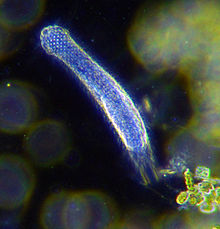Eutely
Appearance

Eutelic organisms have a fixed number of somatic cells when they reach maturity, the exact number being constant for any one species. Development proceeds by cell division until maturity; further growth occurs via cell enlargement only. In nematodes the number of nuclei is also constant; there is growth in size of the body but this is due to the growth in the size of the cells (hypertrophy).
Most eutelic organisms are microscopic. Examples include the rotifers, many species of nematodes (including the model organism Caenorhabditis elegans), tardigrades, larvacea and dicyemida.[1][2]
External links
References
